Fractional Order Curves
Abstract
1. Introduction
2. Preliminaries
2.1. Fractional-Order Grünval–Letnikov Scheme
| Algorithm 1 Algorithm for GL scheme (2) |
 |
2.2. Considered Curves and Fractals
2.2.1. Parametric Curves
| Algorithm 2 Parametric curves representation |
|
2.2.2. Cartesian Curves
- Maps
- Space-filling curves
- Iterated Function Systems (IFS)
2.3. Entropy of a Curve
3. Drawing the Patterns of the FO Curves
3.1. FO Parametric Curves
3.1.1. Surface-Like Curve
3.1.2. Epycicloid
3.2. FO Curlicues
3.3. Space-Filling Curves
3.3.1. Hilbert Curve
3.3.2. Péano Curve
3.4. Koch Fractal Curve
3.5. Barnsley Fern
3.6. FO Dragon Curve
- Consider the curves defined as affine function representations (Hilbert curve, Péano curve, Koch curve, Barnsley fern, and Dragon curve).If the transformations given by (8) did not contain the shift , i.e., , then , which preserves the symmetry induced by A (such as, e.g., (see Hilbert curve in Table 1), which swaps x and y every step). In other words, if T were linear maps (), then the symmetry generated by A would be conserved even by the GL approach (2), and the behavior would be cyclic and predictable.On the other hand, consider that besides the linear maps A, T includes the shift , i.e., they are affine maps (as in all considered cases). Therefore, being applied at every step, the iterations accumulate the shifts over time, which means the system drifts from a purely symmetric evolution and the symmetry is broken.In conclusion, all these curves lose the symmetries existing in their IO counterparts, as the numerical results show.
- If one considers the case of the parametric curves (13) and (15). The first curve has no symmetry, while the second one does (a fact that can be verified analytically). However, except for their size, which reduces for , their shapes do not seem to be affected by the FO approach. This result, as shown in Remark (6) (i), is connected to the nonexistence of the shift (curve expressions do not have constant terms). Moreover, considering the numerical evidence, the symmetry in the parametric curves is not affected by the FO approach.
4. Conclusions
Author Contributions
Funding
Data Availability Statement
Conflicts of Interest
Appendix A
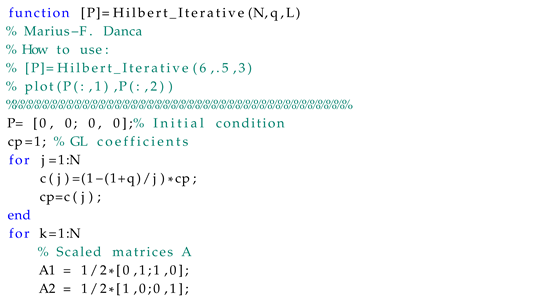

References
- Borwein, J.; Bailey, D. Mathematics by Experiment Plausible Reasoning in the 21st Century; Wellesley: Massachusetts, UK, 2008. [Google Scholar]
- Danca, M.F. Symmetry-breaking and bifurcation diagrams of fractional-order maps. Commun. Nonlinear Sci. Numer. Simul. 2023, 116, 106760. [Google Scholar] [CrossRef]
- Oldham, K.; Spanier, J. The Fractional Calculus: Theory and Applications of Differentiation and Integration to Arbitrary Order; Academic Press: New York, NY, USA, 1974. [Google Scholar]
- Podlubny, I. Geometric and physical interpretation of fractional integration and fractional differentiation. Fract. Calc. Appl. Anal. 2002, 5, 367–386. [Google Scholar]
- Diaz, J.B.; Olser, T.J. Differences of fractional order. Math. Comput. 1974, 28, 185–202. [Google Scholar] [CrossRef]
- Tenreiro, T.G.S.; Machado, J.A.; Oliveira, C.E. A review of definitions of fractional derivatives and other operators. J. Comput. Phys. 2019, 388, 195–208. [Google Scholar]
- Abdeljawad, T. On Riemann and Caputo fractional differences. Comput. Math. Appl. 2011, 62, 1602–1611. [Google Scholar] [CrossRef]
- Atici, F.M.; Eloe, P.W. Initial value problems in discrete fractional calculus. Proc. Am. Math. Soc. 2007, 137, 981–989. [Google Scholar] [CrossRef]
- Cermak, J.; Gyori, I.; Nechvatal, L. On explicit stability conditions for a linear fractional difference system. Fract. Calc. Appl. Anal. 2015, 18, 651–672. [Google Scholar] [CrossRef]
- Chen, F.L. A review of existence and stability results for discrete fractional equations. J. Comput. Complex. Appl. 2015, 1, 22–53. [Google Scholar]
- Wu, G.C.; Baleanu, D.; Zeng, S.D. Several fractional differences and their applications to discrete maps. J. Appl. Nonlinear Dyn 2015, 4, 339–348. [Google Scholar] [CrossRef]
- Wu, G.C.; Baleanu, D.; Xie, H.P.; Chen, F.L. Chaos synchronization of fractional chaotic maps based on the stability condition. Physica A 2016, 460, 374–383. [Google Scholar] [CrossRef]
- Khennaoui, A.A.; Ouannas, A.; Bendoukha, S.; Grassi, G.; Wang, X.; Pham, V.T.; Al-saadi, F.E. Chaos, control, and synchronization in some fractional-order difference equations. Adv. Differ. Equations 2019, 412, 1–23. [Google Scholar] [CrossRef]
- Goodrich, C.; Peterson, A.C. Discrete Fractional Calculus; Springer: Berlin/Heidelberg, Germany, 2015. [Google Scholar]
- Atici, F.M.; Eloe, P.W. Discrete Fractional Calculus with Applications in Difference Equations. J. Math. Anal. Appl. 2009, 369, 1–15. [Google Scholar] [CrossRef]
- Wu, G.C.; Baleanu, D. Discrete chaos in fractional delayed logistic maps. Nonlinear Dyn. 2015, 80, 1697–1703. [Google Scholar] [CrossRef]
- Ferreira, R.A.C.; Torres, D.F.M. Fractional h-difference equations arising from the calculus of variations. Appl. Anal. Discret. Math. 2011, 4, 110–121. [Google Scholar] [CrossRef]
- Lawrence, J.D. A Catalog of Special Plane Curves; Dover: New York, NY, USA, 1972. [Google Scholar]
- Wei, Y.; Cao, J.; Li, C.; Chen, Y. How to empower Grünwald-Letnikov fractional difference equations with available initial condition? Nonlinear Anal. Model. Control 2022, 27, 650–668. [Google Scholar] [CrossRef]
- Danca, M.F. Mandelbrot set as a particular Julia set of fractional order, echipotential lines and external rays of Mandelbrot and Julia sets of fractional order. Fractal Fract. 2024, 8, 69. [Google Scholar] [CrossRef]
- Danca, M.F.; Feckan, M. Mandelbrot set and Julia sets of fractional order. Nonlinear Dyn. 2023, 111, 9555–9570. [Google Scholar] [CrossRef]
- Kunz, E. Introduction to Plane Algebraic Curves; Birkhauser: Basel, Switzerland, 2005. [Google Scholar]
- Pickover, C.A. The fractal golden curlicue is cool. In Keys to Infinity; W. H. Freeman: New York, NY, USA, 1995; pp. 163–167. [Google Scholar]
- Berry, M.V.; Goldberg, J. Renormalisation of curlicues. Nonlinearity 1988, 1, 1–26. [Google Scholar] [CrossRef]
- Romera, M. Técnica de los Sistemas Dinámicos Discretos; Instityuto de Física Aplicada: Madrid, Spain, 1997. [Google Scholar]
- Dekking, M. Paperfolding morphisms, planefilling curves, and fractal tiles. Theor. Comput. Sci. 2012, 414, 20–37. [Google Scholar] [CrossRef]
- Bader, M. Space Filling Curves: An Introduction with Applications in Scientific Computing; Springer: Berlin/Heidelberg, Germany, 2016. [Google Scholar]
- Falconer, K. Fractal Geometry: Mathematical Foundations and Applications; John Wiley & Sons: New York, NY, USA; London, UK, 2003. [Google Scholar]
- Lindenmayer, A. Mathematical models for cellular interactions in development II. Simple and branching filaments with two-sided inputs. J. Theor. Biol. 1968, 18, 300–315. [Google Scholar] [CrossRef]
- Ye, R.; Liu, L. An iterated function system based method to generate Hilbert-type space-filling curves. Int. J. Inf. Technol. Comput. Sci. 2015, 12, 12–22. [Google Scholar] [CrossRef]
- Peano Space-Filling Curve. Available online: https://www.mathworks.com/matlabcentral/fileexchange/130354-peano-space-filling-curve (accessed on 2 February 2025).
- Massopust, P.R. Fractal Peano curves. J. Geom. 1989, 1, 127–138. [Google Scholar] [CrossRef]
- Shannon, C.E. A mathematical theory of communication. Bell Syst. Tech. J. 1948, 27, 379–423. [Google Scholar] [CrossRef]
- France, M.M. Les courbes chaotiques. Courr. Cent. Natl. Recerche Sci. 1983, 51, 5–9. [Google Scholar]
- Dupain, Y.; Kamae, T.; France, M.M. Can one measure the temperature of a curve? Arch. Rational Mech. Anal. 1986, 94, 155–163. [Google Scholar] [CrossRef]
- Balestrino, A.; Caiti, A.; Crisostomi, E. Generalised entropy of curves for the analysis and classification of dynamical systems. Entropy 2009, 11, 249–270. [Google Scholar] [CrossRef]
- Hilbert, D. Über die stetige abbildung einer linie auf ein flachenstück. Math. Ann. 1891, 38, 459–460. [Google Scholar] [CrossRef]
- Peano, G. Sur une courbe, qui remplit toute une aire plane. Math. Ann. 1890, 36, 157–160. [Google Scholar] [CrossRef]
- Mandelbrot, B. The Fractal Geometry of Nature, 3rd ed.; W. H. Freeman and Comp.: New York, NY, USA, 1983. [Google Scholar]
- Addison, P.S. Fractals and Chaos: An Illustrated Course; Institute of Physics: Melville, NY, USA, 1997. [Google Scholar]
- Crinkly Curves by Brian Hayes. Available online: https://www.americanscientist.org/article/crinkly-curves (accessed on 13 March 2025).
- Brian Hayes. Available online: http://bit-player.org/2013/mapping-the-hilbert-curve (accessed on 13 March 2025).
- Barnsley, M. Fractals Everywhere; Academic Press: Boston, MA, USA, 1993. [Google Scholar]
- Gardner, M. Mathematical Magic Show: More Puzzles, Games, Diversions, Illusions and Other Mathematical Sleight-of-Mind from Scientific American; Vintage: New York, NY, USA, 1978. [Google Scholar]
- Weyl, H. Symmetry; Princeton University Press: Princeton, NJ, USA, 1952. [Google Scholar]
- Stewart, I. Why Beauty Is Truth: A History of Symmetry; Basic Books: New York, NY, USA, 2007. [Google Scholar]

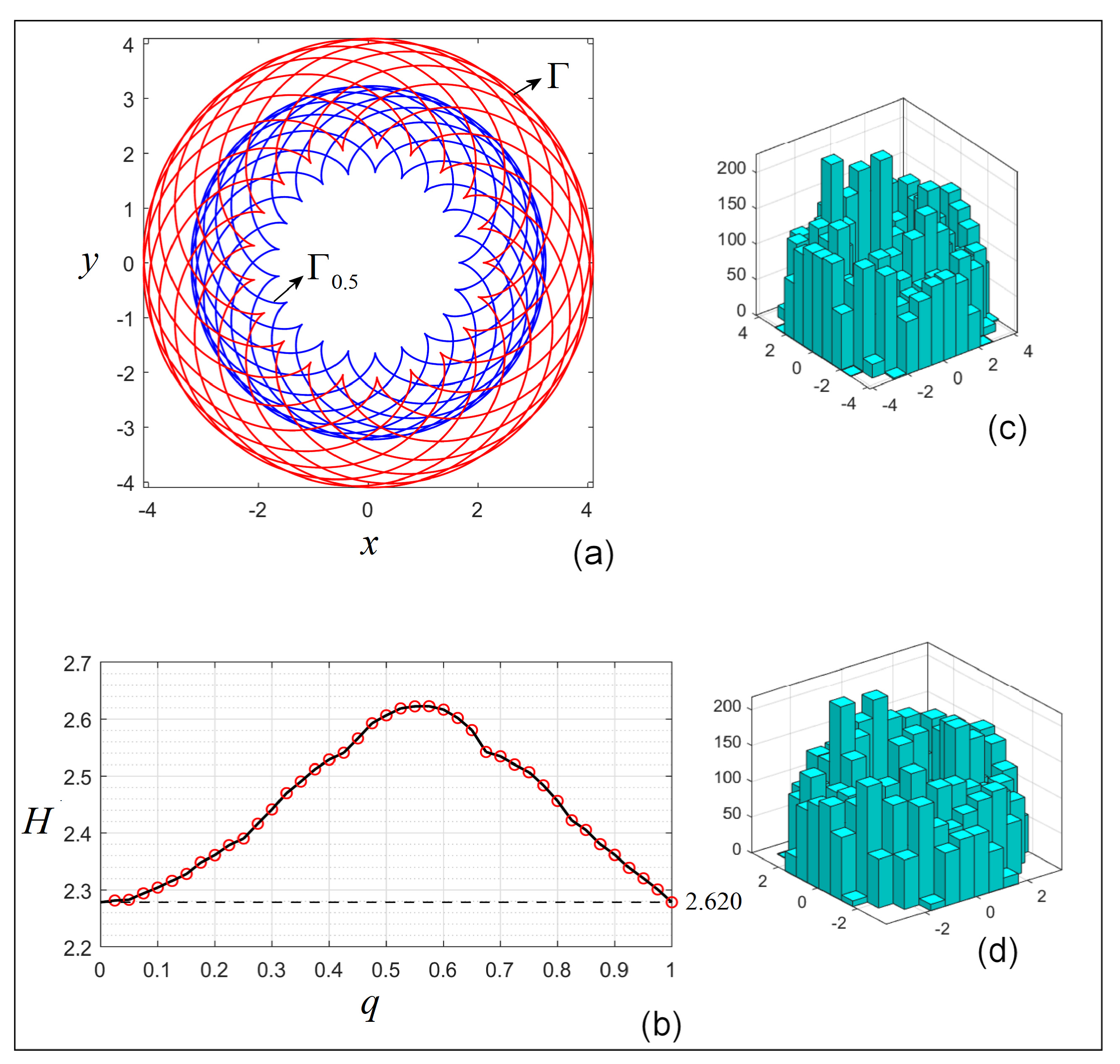

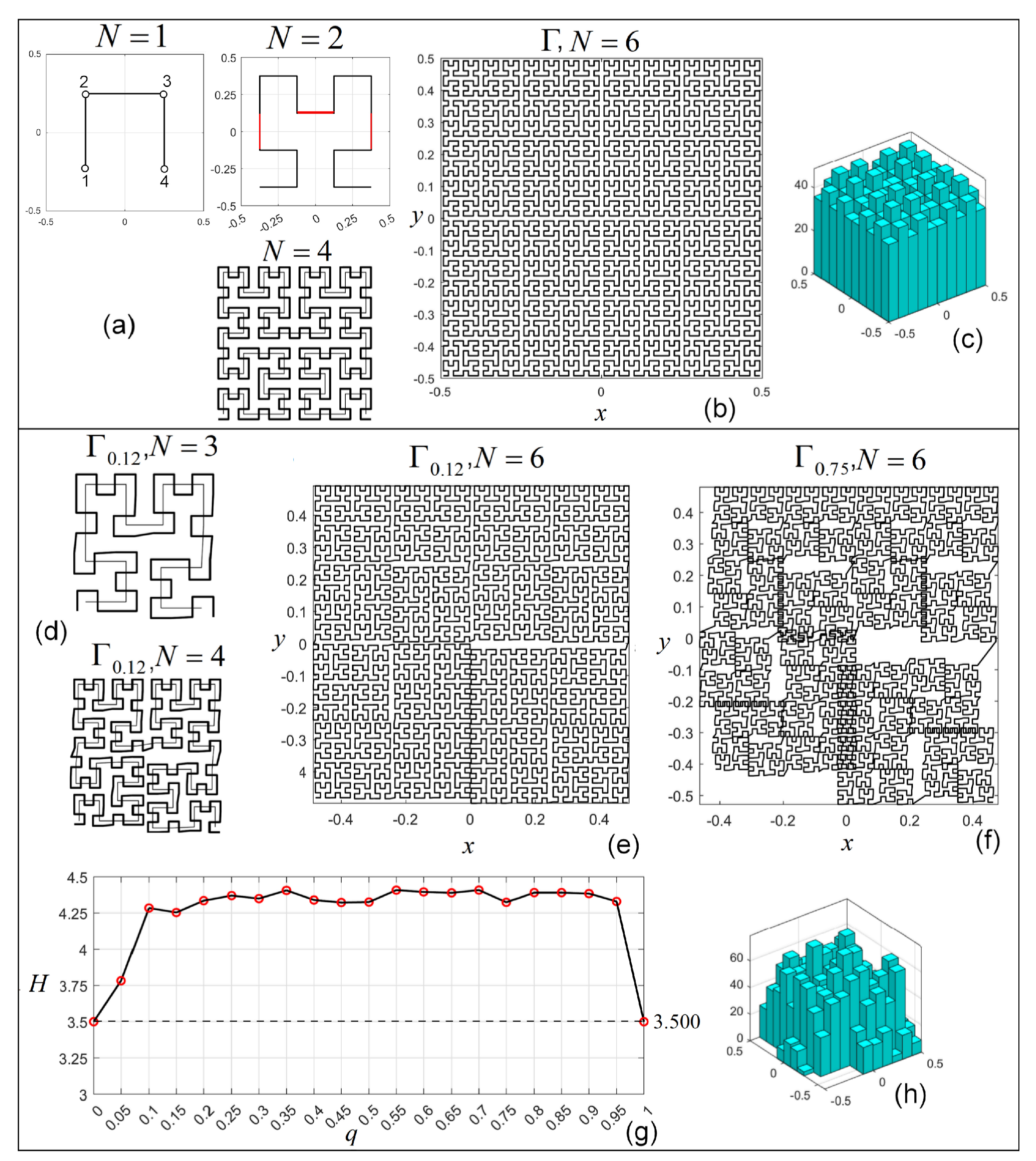
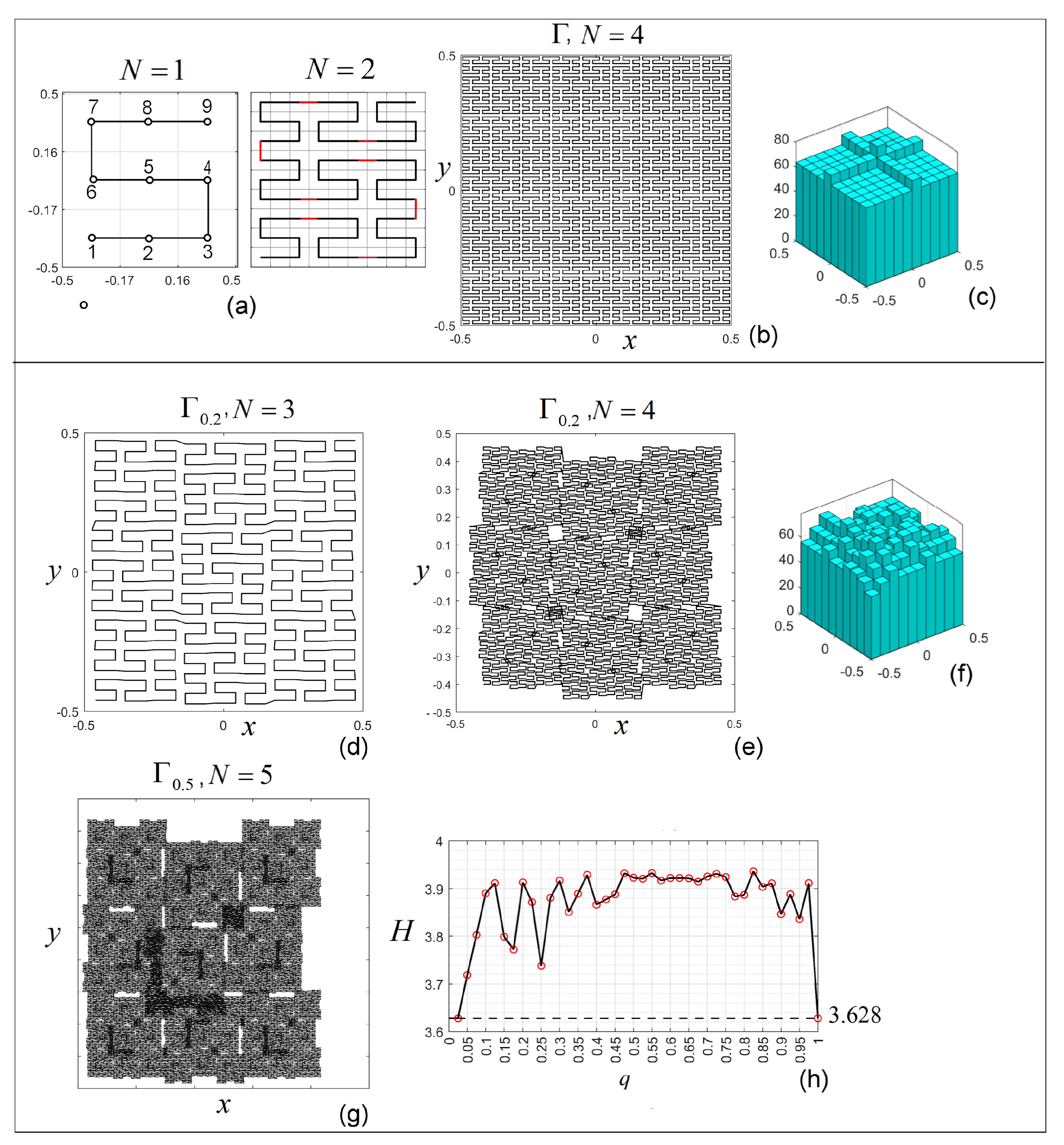

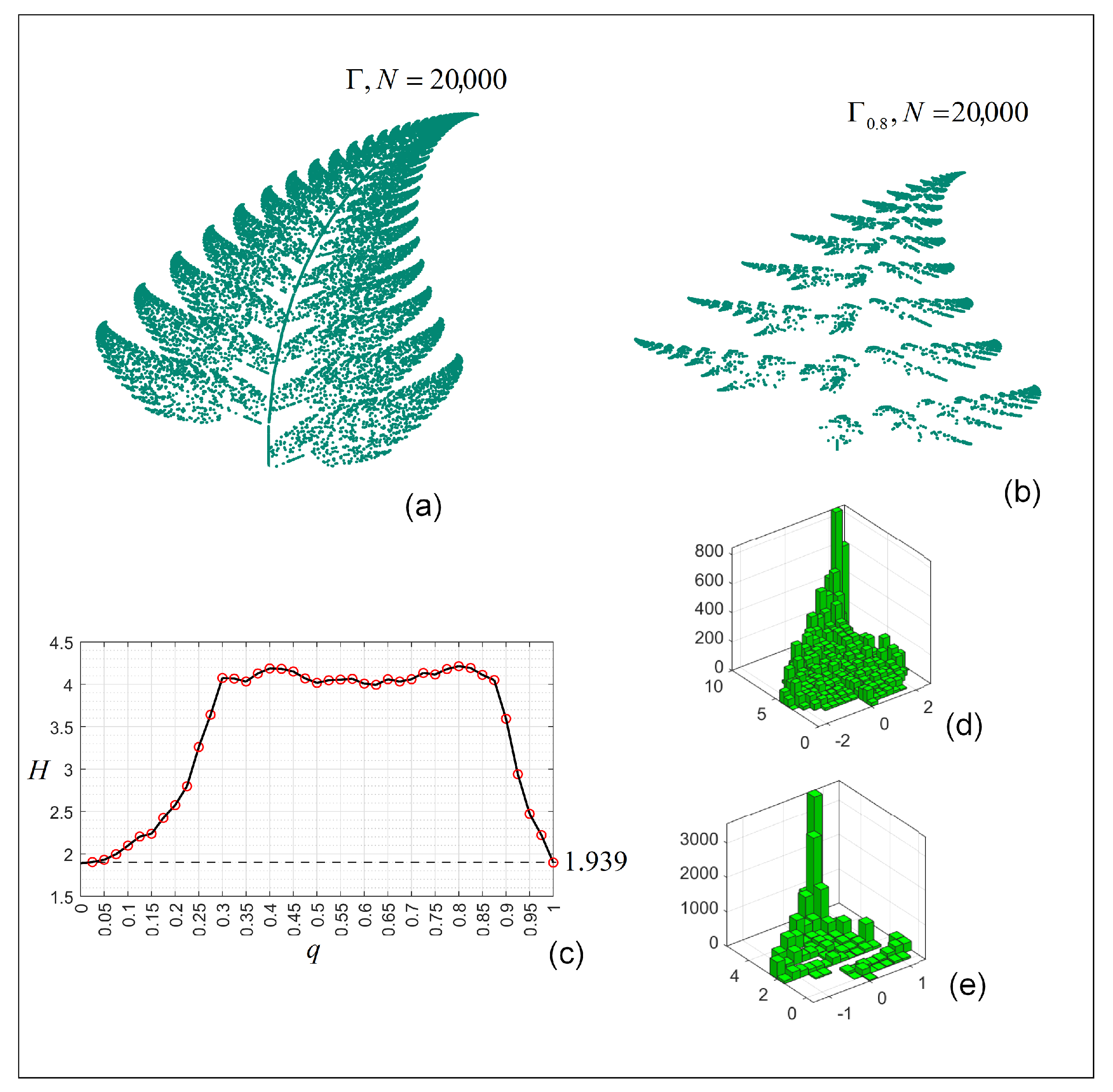
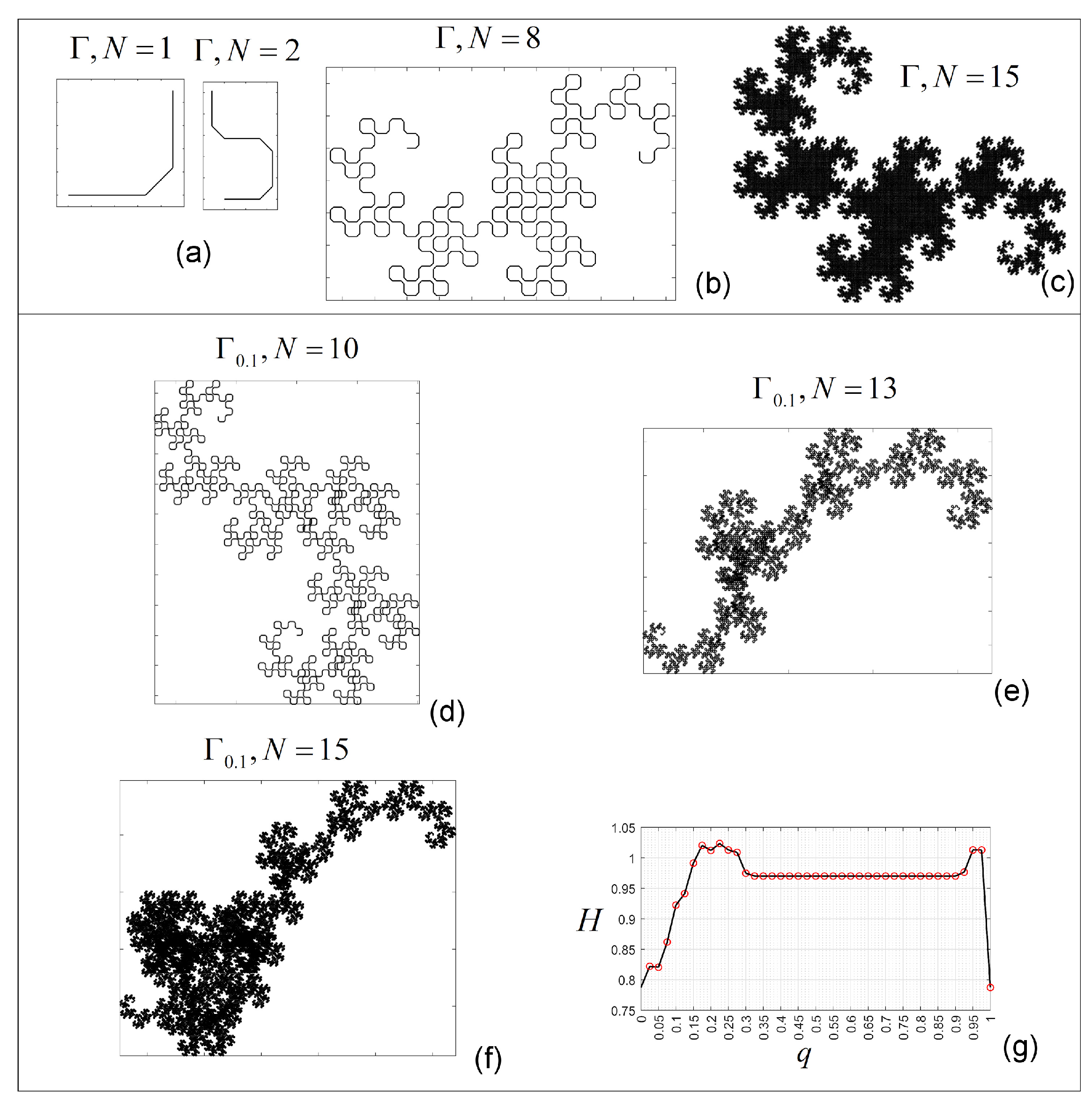
| Curve | A | tr | |
|---|---|---|---|
| Hilbert | |||
| Peano | | ||
| Koch | | ||
| Fern | |
Disclaimer/Publisher’s Note: The statements, opinions and data contained in all publications are solely those of the individual author(s) and contributor(s) and not of MDPI and/or the editor(s). MDPI and/or the editor(s) disclaim responsibility for any injury to people or property resulting from any ideas, methods, instructions or products referred to in the content. |
© 2025 by the authors. Licensee MDPI, Basel, Switzerland. This article is an open access article distributed under the terms and conditions of the Creative Commons Attribution (CC BY) license (https://creativecommons.org/licenses/by/4.0/).
Share and Cite
Danca, M.-F.; Jonnalagadda, J.M. Fractional Order Curves. Symmetry 2025, 17, 455. https://doi.org/10.3390/sym17030455
Danca M-F, Jonnalagadda JM. Fractional Order Curves. Symmetry. 2025; 17(3):455. https://doi.org/10.3390/sym17030455
Chicago/Turabian StyleDanca, Marius-F., and Jagan Mohan Jonnalagadda. 2025. "Fractional Order Curves" Symmetry 17, no. 3: 455. https://doi.org/10.3390/sym17030455
APA StyleDanca, M.-F., & Jonnalagadda, J. M. (2025). Fractional Order Curves. Symmetry, 17(3), 455. https://doi.org/10.3390/sym17030455






